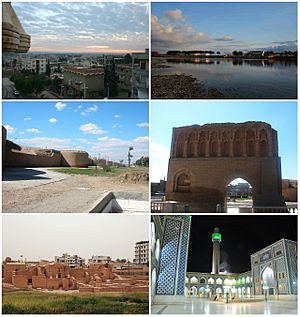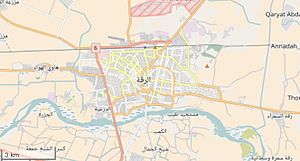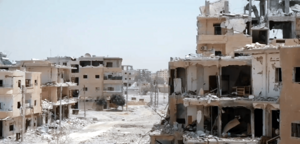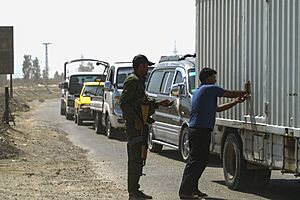Raqqa facts for kids
Quick facts for kids
Raqqa
ٱلرَّقَّة
|
|
|---|---|
|
City
|
|

Raqqa skyline • The Euphrates
Raqqa city walls • Baghdad gate Qasr al-Banat Castle • Uwais al-Qarni Mosque |
|
| Lua error in Module:Location_map at line 416: Malformed coordinates value. | |
| Country | |
| Governorate | Raqqa |
| District | Raqqa |
| Subdistrict | Raqqa |
| Founded | 244–242 BC |
| Control | |
| Area | |
| • City | 35 km2 (14 sq mi) |
| Elevation | 245 m (804 ft) |
| Population
(2021 estimate)
|
|
| • City | 531,952 |
| • Density | 15,200/km2 (39,400/sq mi) |
| Demonym(s) | Arabic: رقاوي, romanized: Raqqawi |
| Time zone | UTC+2 (EET) |
| • Summer (DST) | UTC+3 (EEST) |
| P-Code |
C5710
|
| Area code(s) | 22 |
| Geocode | SY110100 |
Raqqa (Arabic: ٱلرَّقَّة, romanized: ar-Raqqah) is a city in Syria, located on the left bank of the Euphrates River. It is about 160 kilometers (100 miles) east of Aleppo. Raqqa is also 40 kilometers (25 miles) east of the Tabqa Dam, which is Syria's largest dam.
This city has a long history. It was once the capital of the Abbasid Caliphate from 796 to 809 AD, under the rule of Harun al-Rashid. More recently, it was the capital of the Islamic State (ISIS) from 2014 to 2017. In 2021, Raqqa had a population of 531,952, making it the sixth largest city in Syria.
During the Syrian Civil War, rebel groups took control of Raqqa in 2013. Then, ISIS took over and made it their capital in 2014. Because of this, the city was heavily bombed by Syria, Russia, the United States, and other countries. ISIS destroyed many religious buildings that were not Sunni, like the Shia Uwais al-Qarni Mosque. On October 17, 2017, after a long and destructive battle, the Syrian Democratic Forces (SDF) announced that Raqqa was free from ISIS.
Contents
- Exploring Raqqa's Past: A Journey Through Time
- Ancient Beginnings: Nikephorion and Kallinikos
- Roman and Byzantine Eras: Changes and Conflicts
- Early Islamic Period: The Rise of Al-Raqqah
- Abbasid Period: Raqqa as a Capital City
- Decline and Bedouin Rule
- A Second Flourishing: Zangid and Ayyubid Eras
- Ottoman Period: Rebuilding and Settlement
- 20th Century: Growth and Changes
- Syrian Civil War: Conflict and Recovery
- Religious Heritage: Faith and Community
- Media and Stories from Raqqa
- Transportation in Raqqa
- Climate of Raqqa
- Famous People from Raqqa
- Images for kids
- See Also
Exploring Raqqa's Past: A Journey Through Time
Ancient Beginnings: Nikephorion and Kallinikos
People have lived in the Raqqa area for a very long time. Evidence of ancient settlements can be found in mounds like Tall Zaydan. The modern city's story began in the Hellenistic period. This was when the city of Nikephorion was founded.
Historians believe that either Alexander the Great or Seleucus I Nicator founded the city. Later, Seleucus II Callinicus made the city bigger and renamed it Kallinikos after himself.
Roman and Byzantine Eras: Changes and Conflicts
During Roman times, Kallinikos was part of the province of Osrhoene. It became less important by the 300s AD. However, Byzantine Emperor Leo I rebuilt it in 466 AD and named it Leontopolis. Still, the name Kallinikos remained popular.
The city was important in the wars between the Byzantine Empire and Sassanid Persia. It was one of the few places where the two empires could officially trade. In 531, a major battle happened near the city between the Romans and Sasanians. The Persians won, but both sides lost many soldiers.
In 542, the Persian Emperor Khusrau I destroyed the city and sent its people to Persia. But Justinian I rebuilt it. Before it came under Muslim rule, Kallinikos was a very important city in the region.
Early Islamic Period: The Rise of Al-Raqqah
In 639 or 640 AD, Muslim conquerors took over the city. It was then called al-Raqqah, meaning "the marsh", because of the wet land around it. The Christian people of the city made a treaty that allowed them to keep their churches. However, they could not build new ones.
Raqqa had a strong Christian community for many centuries. It also had a Jewish community until at least the 1100s. The city's first mosque was built by Sa'id ibn Amir ibn Hidhyam. This mosque was later made much larger.
In 656, a big battle called the Battle of Siffin happened near Raqqa. This battle was between Ali and Mu'awiya. The tombs of some of Ali's followers, like Ammar ibn Yasir and Uwais al-Qarani, are in Raqqa. These tombs became important places for pilgrims.
Raqqa remained a key regional center under Umayyad rule. The Umayyads invested in farming, which helped the area's economy grow.
Abbasid Period: Raqqa as a Capital City
The importance of Raqqa grew during the wars between the Umayyad and Abbasid empires. Raqqa was located at a crossroads between Syria and Iraq.
In 770-771 AD, the Abbasid caliph al-Mansur decided to build a new military city called al-Rāfiqah. This new city was built about 200 meters (650 feet) west of old Raqqa. It was meant to strengthen the empire's defenses, especially near the Byzantine border. Al-Rafiqah was the largest and most important of these new constructions.
The plan for al-Rafiqah was similar to Baghdad's, but it was smaller and had stronger defenses. Its massive city walls, which were 6.2 meters (20 feet) thick, still stand today. The city also had a large mosque, which was the first to be built from scratch with a clear plan. This mosque influenced later mosque designs.
At first, the people of old Raqqa were not happy about the new military settlement. They worried about higher living costs. The new residents were soldiers from Khorasan, different from the Christians and Arabs already living there.
By 785, the old market in Raqqa was too small for both cities. So, the governor moved the market to the area between Raqqa and al-Rafiqah. This area became a busy industrial and commercial district.
Raqqa and al-Rafiqah eventually merged into one large city. In 796, Caliph Harun al-Rashid chose Raqqa/al-Rafiqah as his imperial home. For about 13 years, Raqqa was the capital of the Abbasid Caliphate. This empire stretched from North Africa to Central Asia. Even though the main government offices stayed in Baghdad, Raqqa was a very important center.
Harun al-Rashid also built a large "palace city" north of Raqqa. This area covered about 10 square kilometers (4 square miles). It had palaces, gardens, and canals for water. Only a small, restored building called the Eastern Palace remains today.
Raqqa was also a major center for making glass and ceramics. The city's port on the Euphrates River was important for trade. Goods from northern Syria and Mesopotamia were shipped from Raqqa to Baghdad and other parts of Iraq. Raqqa also had a mint that made coins.
Decline and Bedouin Rule
Raqqa's importance decreased in the late 800s. This was due to ongoing wars and conflicts. By the 940s, under the Hamdanid rulers, the city rapidly declined. It lost its status as a military city, which hurt its economy.
From the late 900s to the early 1100s, Bedouin (nomadic Arab tribes) ruled Raqqa. These rulers were mostly nomads and were not very interested in developing cities. During this time, the area used for farming shrank, and trade routes became less safe due to raids.
A Second Flourishing: Zangid and Ayyubid Eras
Raqqa saw a new period of growth in the 1100s and early 1200s. This was during the Zangid and Ayyubid periods. Farming and industry, especially the production of blue-glazed Raqqa ware pottery, thrived again.
Important buildings from this time include the Bāb Baghdād (Baghdad Gate) and the Qasr al-Banāt (Castle of the Ladies). The famous ruler 'Imād ad-Dīn Zangī was first buried in Raqqa. However, the city was destroyed during the Mongol invasions of the Levant in the 1260s.
Ottoman Period: Rebuilding and Settlement
In the 1500s, Raqqa became an Ottoman customs post on the Euphrates. The province of Raqqa was created in 1586. However, the capital of the province was actually Urfa, not Raqqa.
In the 1800s, Raqqa was mainly a winter home for nomadic tribes. The modern city began to revive in 1864 when the Ottomans set up a military garrison there. The first families to settle in modern Raqqa used ancient bricks from the old city walls to build their homes.
These families formed alliances with surrounding Arab and Kurdish tribes for protection. The Raqqa Museum is housed in a building that was built in 1861 and was originally an Ottoman government building.
20th Century: Growth and Changes
In the early 1900s, refugees from the Caucasian War and the Armenian genocide settled in Raqqa. Many Armenians later moved to Aleppo, but they still form the majority of Raqqa's Christian community.
In the 1950s, a worldwide demand for cotton led to huge growth in Raqqa. Cotton is still the main farm product in the region. This growth also led to the destruction of many ancient ruins as new buildings were constructed.
Archaeologists have worked to explore and protect the remaining historical sites, like the Abbasid city walls and the Baghdad Gate.
Syrian Civil War: Conflict and Recovery
In March 2013, during the Syrian civil war, rebel groups took control of Raqqa. It was the first provincial capital to fall to the rebels. The Al Qaeda-linked Al-Nusra Front set up a religious court. Then, the Islamic State of Iraq and the Levant (ISIL) took full control of Raqqa by January 2014.
ISIL made Raqqa its capital. They destroyed Shia mosques and Christian churches, turning some into police headquarters. Many Christians fled the city.
Because it was ISIL's capital, Raqqa was heavily bombed by various countries. On June 6, 2017, the Syrian Democratic Forces (SDF), supported by the US, launched a major battle to take Raqqa back. They declared victory on October 17, 2017. The bombing caused massive destruction to the city. About 270,000 people had to leave Raqqa.
After the battle, the Syrian government stated that Raqqa was still an "occupied city" because the Syrian army had not entered it.
Rebuilding Raqqa: Life After Conflict
By June 2019, about 300,000 people had returned to Raqqa. Many shops reopened. With help from the Global Coalition and the Raqqa Civil Council, hospitals, schools, museums, and parks have been reopened or restored. Roads, bridges, and streetlights are being rebuilt.
However, rebuilding homes and businesses is mostly up to the people themselves. There is still rubble, and electricity and water can be unreliable in some areas. ISIS sleeper cells and hidden bombs are still a danger.
In February 2019, a large mass grave with about 3,500 bodies was found. These were believed to be victims of ISIS executions. In April 2019, the Old Raqqa Bridge over the Euphrates was repaired. The National Hospital also reopened in May 2019.
In 2019, the SDF asked the Syrian Arab Army to enter areas under its control, including Raqqa. This was part of a deal to stop Turkish troops from taking more territory in northern Syria.
Scanning for Syria: Preserving History Digitally
The Raqqa Museum had many ancient clay tablets with cuneiform writing. These were lost during the war. Luckily, archaeologists had made silicone rubber molds of some tablets before the war. These molds became the only copies of these important historical records.
To protect this information, the Scanning for Syria (SfS) project began. Researchers used 3D scanning and 3D printing to make high-quality copies of the tablets from the molds. They used X-ray micro-CT scanners to get detailed digital 3D models. This project helps scholars study the texts and allows others to experience ancient Assyrian writing through 3D-printed replicas. In 2020, the project won a European Union cultural heritage award.
Religious Heritage: Faith and Community
Raqqa has a long history of different religious communities. It was an important center for Assyrian monasticism in the 500s AD. The Saint Zacchaeus Monastery was very famous.
Even though Raqqa has not had a large Shi'i community, it became an important place for Shi'i pilgrims from Iran. This was especially true when other holy cities were hard to reach. The tombs of Ammar ibn Yasir and Uways al-Qarani, two companions of Muhammad, are major attractions. New mosques were built over these tombs, making them large Shi'i shrines. However, ISIS destroyed the Uways mosque in 2014.
Uways al-Qarani is a very important religious figure in Raqqa. He is seen as the city's "patron saint." People believed he protected a large mulberry tree east of the city. Until the 1940s, nomadic families would leave their belongings at the tree before moving their livestock for the summer. They believed no one would dare steal them because of the saint's protection.
Uways was also seen as a helper in solving thefts. If something valuable went missing, a special procession would take place with a copper cup called the "Uways Cup." The whole city was considered a sacred space during these events.
Media and Stories from Raqqa
During ISIL's rule, they banned all outside media. However, a group called Raqqa Is Being Slaughtered Silently (RBSS) secretly reported on life inside the city. ISIL killed members of this group. A film about RBSS, called City of Ghosts, was released in 2017 and won an award at the Sundance Film Festival.
In 2016, a French author named Sophie Kasiki published a book about her experience. She was tricked into moving to Raqqa in 2015 to work in a hospital and later escaped from ISIL.
Transportation in Raqqa
Before the Syrian Civil War, the city was served by the Chemins de Fer Syriens railway system.
Climate of Raqqa
Raqqa has a hot desert climate. This means it has very hot summers and mild winters. Rainfall is very low, especially during the summer months.
| Climate data for Raqqa | |||||||||||||
|---|---|---|---|---|---|---|---|---|---|---|---|---|---|
| Month | Jan | Feb | Mar | Apr | May | Jun | Jul | Aug | Sep | Oct | Nov | Dec | Year |
| Record high °C (°F) | 18 (64) |
22 (72) |
26 (79) |
33 (91) |
41 (106) |
12 (54) |
17 (63) |
13 (55) |
10 (50) |
2 (36) |
−2 (28) |
−5 (23) |
47 (117) |
| Mean daily maximum °C (°F) | 12 (54) |
14 (57) |
18 (64) |
24 (75) |
31 (88) |
36 (97) |
39 (102) |
38 (100) |
33 (91) |
29 (84) |
21 (70) |
16 (61) |
26 (79) |
| Mean daily minimum °C (°F) | 2 (36) |
3 (37) |
5 (41) |
11 (52) |
15 (59) |
18 (64) |
21 (70) |
21 (70) |
16 (61) |
12 (54) |
7 (45) |
4 (39) |
11 (52) |
| Record low °C (°F) | −7 (19) |
−7 (19) |
−2 (28) |
2 (36) |
8 (46) |
— | — | — | — | — | — | — | −7 (19) |
| Average precipitation mm (inches) | 22 (0.9) |
18.2 (0.72) |
24.3 (0.96) |
10.2 (0.40) |
4.5 (0.18) |
0 (0) |
0 (0) |
0 (0) |
0.1 (0.00) |
3.1 (0.12) |
12.4 (0.49) |
13.6 (0.54) |
108.4 (4.31) |
| Average precipitation days | 7 | 6 | 5 | 5 | 2 | 0 | 0 | 0 | 0.1 | 2 | 3 | 6 | 36.1 |
| Average relative humidity (%) | 76 | 72 | 60 | 53 | 45 | 34 | 38 | 41 | 44 | 49 | 60 | 73 | 54 |
Famous People from Raqqa
- Al-Battani: A famous astronomer, astrologer, and mathematician who lived from about 858 to 929 AD.
- Abdul-Salam Ojeili: A novelist and politician who lived from 1918 to 2006.
- Harun al-Rashid: The fifth Abbasid Caliph, who ruled from 786 to 809 AD and made Raqqa his capital.
- Khalaf Ali Alkhalaf: A poet and writer born in 1969.
- Yassin al-Haj Saleh: A writer and activist born in 1961.
Images for kids
-
Ewer, late 12th–first half of the 13th century, from Raqqa. Metropolitan Museum of Art.
See Also
 In Spanish: Al Raqa para niños
In Spanish: Al Raqa para niños








